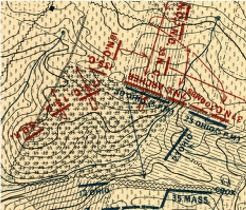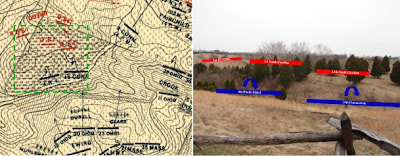
The men of Ewing’s Brigade of the Kanawha Division steadied themselves behind the fence rails along the Otto farm lane as men of the 16th Connecticut and 4th Rhode Island streamed past. The Ninth Corps’ flank, and the success of their drive toward Sharpsburg, threatened to unravel under the relentless pressure of A.P. Hill’s slashing attacks. As Gregg’s South Carolinians drove eastward through the 40 Acre Cornfield, Archer’s Brigade formed along the Harper’s Ferry Road and prepared to join the fray.
The 23rd and 30th Ohio regiments of Ewing’s brigade scaled the fence in their front and steeled themselves to repel the rebels closing in from the south and west. The 23rd Ohio drove westward just to the north of the corn, while the 30th Ohio moved to the bottom of the ravine, entered the corn, and drove up the opposite slope. Once more, however, confusion reigned in the Federal ranks, and the 12th Ohio failed to advance with the rest of the brigade. Both the 23rd and 30th Ohio halted at the stone wall bordering the western end of the cornfield and poured a telling fire into the flank of the 7th and 37th North Carolina regiments of Branch’s Brigade, the second of A.P. Hill’s units to reach the field. The North Carolina regiments recoiled under this fire, but support was not far behind.
Archer’s tiny brigade of Hill’s division, reduced to less than 400 men by the grueling march from Harper’s Ferry, drove west from the Harpers Ferry road and charged the stone wall manned by Ewing’s Ohio regiments. At first, the Ohio boys held their own. Gregg’s men, however, still held the southern and western portions of the cornfield, and increased the pressure on the Ohioan’s flank until the position at the wall became untenable. Ewing refused his left flank, facing the 23rd and several companies of the 30th Ohio to the southwest. Other companies of the 30th Ohio retired east toward the Otto Farm Lane, where they mingled with remnants of the 16th Connecticut of Harland’s brigade.
Ewing’s last regiment, the 12th Ohio, nearly broke under a prolonged fire of infantry and artillery, some of it from friendly batteries. At length, the regiment took position along the western fence line of the Otto Farm Lane, unwilling to advance into the teeth of Gregg’s veterans, convinced that the same unhappy fate that befell Harland’s regiments awaited them in the broad expanse of corn to their front.
As dusk settled over the smoke filled ravines of the Otto Farm, Gregg’s men consolidated their position. Sturgis’s division of the Ninth Corps, having replenished its ammunition after its fight for the Rohrbach Bridge, relieved Ewing’s hard pressed brigade and took position along the Otto Farm Lane, facing west. These Federals engaged Archer’s and Gregg’s men with a desultory fire until dusk put an end to the contest.
A. P. Hill’s driving counterattack had unraveled the Ninth Corps offensive. Hill’s veterans exploited the rugged, confused terrain south of Sharpsburg and fought with determination and vigor. Behind the scenes, Lee himself drove every serviceable gun he could find into action along the ridge crowned by the Harpers Ferry Road, while McClellan, fretting precious hours away at the Pry House east of Antietam Creek, sent only a single battery to support the Ninth Corps in its hour of need.
Darkness brought an end to the fighting. Though Burnside expressed his willingness to continue the fight on the morrow if properly supported, McClellan would let September 18th pass without action. Lee’s army withdrew across the Potomac the following day, and but for a short, sharp action at the ford below Shepherdstown, the Maryland campaign was over.

